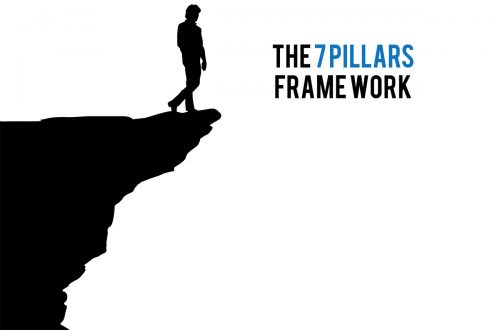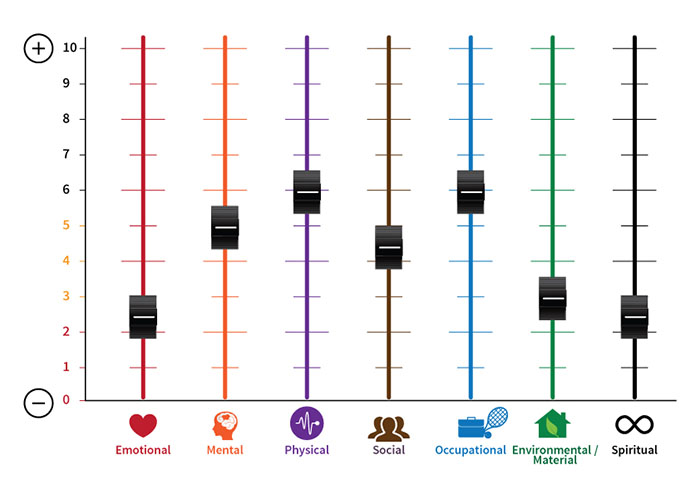
Every day, we are confronted with thousands of thoughts and feelings as we interact with our environment—our friends and families, our work, and our hobbies. In the complex modern world we live in with an endless flow of stimuli, a constant bombardment of information, and difficult choices that require our immediate attention, it is easy to get disoriented. How do we determine which choices to make and what path to follow? How do we make sense of it all? And how can we know which choices will lead to more satisfaction in life, or better mental or physical health? The 7 Pillars Framework aims to answer these questions.
At the core, the framework has three main components.
First, you learn to organize this complex world we live in through the lens of the 7 pillars (see below).
The 7 Pillars are
- Emotional: how you feel
- Mental: thoughts, knowledge, and mental health
- Physical: your body and overall physical health
- Social: connection to others
- Occupational: what you do (work, hobbies, etc.)
- Environmental/Material: home, surroundings, and possessions
- Spiritual: connection to the sacred

The pillars are organized in a way to facilitate remembering. At the center is the heart, the metaphorical seat of your emotions. One of the objectives of the framework is to change overall how you feel and improve your perceived well-being and quality of life. Above is the mental pillar, and below the physical pillar. Then you have the connection pillars: connection to your environment and material things, to the spiritual, to others and to your occupations. Each of the pillars plays a fundamental role in your life, and their respective strength will determine your overall sense of well-being. The pillars are composed of building blocks; the framework identifies 3 for each pillar — in other words, 21 building blocks in total. You will be encouraged to take small actions in each building block, which in turn can have a dramatic impact on your life. Note that since we are all different, the impact and importance of each pillar will vary from one person to the other.
Second, when assessing all the options and choices in front of you, you will uncover a powerful yet simple visual method (the + and – assessment tool) to determine if an outcome will most likely strengthen or weaken you. By picturing in your mind a series of levers (see below), ranging from 0 (-) to 10 (+), you will be able to evaluate the potential impact of your choices.
+ Positive, Constructive => Strengthening

– Negative, Destructive => Weakening
Note: we use a 0 to 10 scale, with 10 being the most strengthening and empowering, and 0 the most weakening.

Finally, you will discover a simple step by step process called the Momentum Wheel, or AAAAA to assist you in your transformation: Aim, Awareness, Assessment, Acceptance and Action (AAAAA).
- AIM:
you must define your aim, what is it that you want, what direction you want to go, what outcome you are desiring? - AWARENESS:
you must become aware of where you are, the past, your choices, who you have become (externally and internally), and what your values and beliefs are. You will learn to be aware in every moment, and make decisions consciously. - ASSESSMENT:
what are the options and choices available now, and how will they impact you? Will a particular decision strengthen or weaken certain Pillars? You assess the potential impact of the choices you have and the decisions you are about to make. you must become aware of where you are, the past, your choices, who you have become (externally and internally), and what your values and beliefs are. - ACCEPTANCE:
let go of the past, the “what if I had done this or that”, the “I wish I had”, and focus on the present moment. Learn to forgive yourself and others while taking ownership of your life. - ACTION:
start to make conscious decisions and take control of each step you take, how you adjust to circumstances, and the direction you pursue. Learn from the actions you take (awareness), accept the results, and make a correction for your next actions.Keep testing, adjusting, and repeating this cycle in endless corrective loops: Aim – Awareness – Acceptance – Action. Repeat.
The 7 Pillars helps you to gain a better understanding of the options you have, as well as the impact on your life of the decisions you take. In other words, the framework provides a guide to assist you in making choices that lead to more frequent and sustained positive emotions.
Over the past decades, there has been an abundance of research that demonstrated how improvements in each of the pillars can have a profound positive impact on our lives. By putting the framework into practice, you will shift, over time, the mix in your life to include more of what inspires, strengthens, and empowers you, and what brings you joy.
At the core of the framework lies one key assumption and three core principles.
Key assumption: everything you do has an impact that can either strengthen or weaken you.
3 Core Principles and formulas
Simplicity, structured approach, and small steps. The framework is founded on a step-by-step structured process of small incremental change that (over time) leads to a deep and profound transformation. I have made a conscious effort to simplify—even over-simplify—complex concepts. Simple solutions seem to work best in today’s overly technical and fast-paced world.What is truly unique here is the framework provided, the concrete approach, and the holistic and integrative view.
In many ways, it will encompass nearly all the critical areas of your life. The framework provides practical applications, with 3 formulas that showcase clear examples of how it can be implemented in your life. You will become aware of your own patterns and how your emotions evolve and change as you test, learn, and experiment.
Exercises
The 7 Pillars provides a multitude of simple exercises to illustrate the concepts and demonstrate how they apply to your life. You will practice and become familiar with the loop of awareness, acceptance, and get you to start taking concrete actions and small steps. For instance, using wonder, beauty, and gratitude to reflect upon the amazing occurrences in your life will set you up for more of them. By planning a life of self-driven purpose, you will see the joy and beauty in what you do:
– WOW:
develop a sense of wonder, like a child that sees the world through his/her wondrous eyes. Say out loud: “WOW, look at…” or “WOW, that’s amazing”. It can be as simple as a beautiful cloud formation, a sunset, a beautiful house, the fact that you have hot water…
– BEAUTY:
notice something beautiful, and say out loud: “that is so beautiful”. It can be in nature, or it can be about how something works and functions, as one can find beauty and light in everything. Don’t just say it; feel the sensation of observing beauty in your whole being.
– GRATITUDE:
Five times per day, practice identifying 5 things you are grateful for. Be truthful and honest, and keep it simple. Make sure that each time, the 5 things are different. Connect to the feeling of gratefulness, the positive release it provides inside of you when you truly feel grateful for something in your life.
It may simply be feeling the sun on your face that day, being in a park, having a job, or the smile of your children.
Planning Your Journey
As your journey unfolds, you have the choice of which way to travel. At each moment on the path of life, you make decisions, which can be conscious or unconscious. These can empower you and help you grow, or pull you down and restrain you. This is very different from just passively reacting to events. Each choice takes you one step forward on your journey.
You are the one taking these steps, deciding to stay on the path or to veer off course, to stay put or move ahead, and to climb-up or slide downward. The boulders that lie in your way, as well as the mountains and deserts that you suddenly face, are all part of the external world. Of course, they have an impact on you, create constraints, and influence your choices. However, they are separate from you. You must detach yourself from the external, from everything that is out of your control, and focus consciously on the moment, on the now, when choices are being made. You have the power because of this ability to always make choices. Every time you consciously chose a path, you are setting a direction for your journey.
The last chapter in the book, titled The Workbook, is filled with exercises to take you from theory to practical application. After identifying what is important to you in life, understanding your core beliefs and values and assessing where you stand today in each of the Pillars, you are ready to build your plan.


